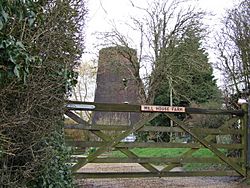Aslacton Windmill facts for kids
Quick facts for kids Aslacton Windmill |
|
|---|---|

The derelict mill in 2007
|
|
| Origin | |
| Mill name | Aslacton Mill |
| Coordinates | 52°28′07″N 1°10′29″E / 52.46861°N 1.17472°E |
| Operator(s) | Private |
| Year built | 1834 |
| Information | |
| Purpose | Corn mill |
| Type | Tower mill |
| Storeys | Four storeys |
| No. of sails | Four sails |
| Type of sails | Double Patent sails |
| Winding | Fantail |
| Fantail blades | Six blades |
| Auxiliary power | Steam engine, later replaced by an oil engine |
| No. of pairs of millstones | Two pairs |
Aslacton Mill is an old windmill located in Aslacton, Norfolk, England. It is a special type of building called a tower mill. It is also a Grade II listed building, which means it is important and protected because of its history. Today, the mill is no longer working and is mostly a ruin.
Contents
History of Aslacton Mill
Aslacton Mill was likely built in 1834. However, there was a mill in Aslacton even earlier, possibly as far back as 1751.
Early Millers and Owners
The first miller recorded at Aslacton Mill was Benjamin Gibson, who worked there from 1841 to 1868. Later, Barnabas Burroughes owned the mill from 1872 until he passed away in 1899.
After Barnabas Burroughes's death, the mill went to his widow. When she passed away in 1903, the mill was put up for sale. It was offered at an auction in Tivetshall, but the highest bid was too low, so it didn't sell right away.
Changing Hands
In October 1903, Samuel Fickling bought the mill. After he died in 1913, his widow took over. Then, in 1915, their son Arthur Robinson Fickling sold it to Selina Herring.
The mill was sold again in 1929 to John Colchester. Around 1930, the large sails of the windmill were removed. From then on, the mill was powered by a Steam engine, and later by an oil engine, instead of wind. John Colchester continued to operate the mill with engines until 1938.
Today, the old tower of Aslacton Mill still stands, and you can still find some of its original machinery inside.
How Aslacton Mill Worked
Aslacton Mill is a four-story tower mill. This means it has a tall, round stone tower.
Key Parts of the Mill
- Cap and Fantail: The mill used to have a special top part, called a "cap," which was shaped like a boat. This cap would turn to face the wind. It was turned by a six-bladed fantail, which is like a small windmill at the back of the cap.
- Sails: The mill had four large double Patent sails. These sails would catch the wind and make the machinery inside turn.
- Millstones: Inside, the mill had two pairs of millstones. These heavy stones were used to grind corn into flour.
- Power System: What was interesting about Aslacton Mill is how the millstones were powered. When using wind power, the stones were driven overdrift (meaning the power came from above). But when the mill used an engine, the stones were driven underdrift (meaning the power came from below).
- Size: The tower itself is about 33 feet (10.06 m) tall from its base to where the cap used to sit.
Even though the mill is no longer working, some important parts of its internal machinery, like the upright shaft and great spur wheel for the engine drive, are still in place.
Millers of Aslacton Mill
Here is a list of some of the millers who worked at Aslacton Mill:
- Benjamin Gibson (1841-1868)
- Barnabas Borroughes (1872-1898)
- Jane Burroughes (1900)
- George Leonard Smith (1900-1901)
- Robert William Drane (1904-1908)
- William Samuel Herring (1912)
- Selina Herring (1915-1916)
- Charles William Herring (1922-1928)
- John Corben Colchester (1929-1938)
- Samuel McMeakin (1937)

